Exploring the Vibrant Spectrum of Topaz Colors
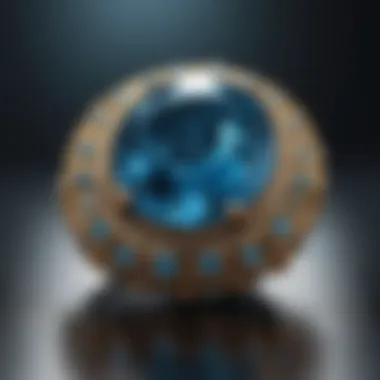
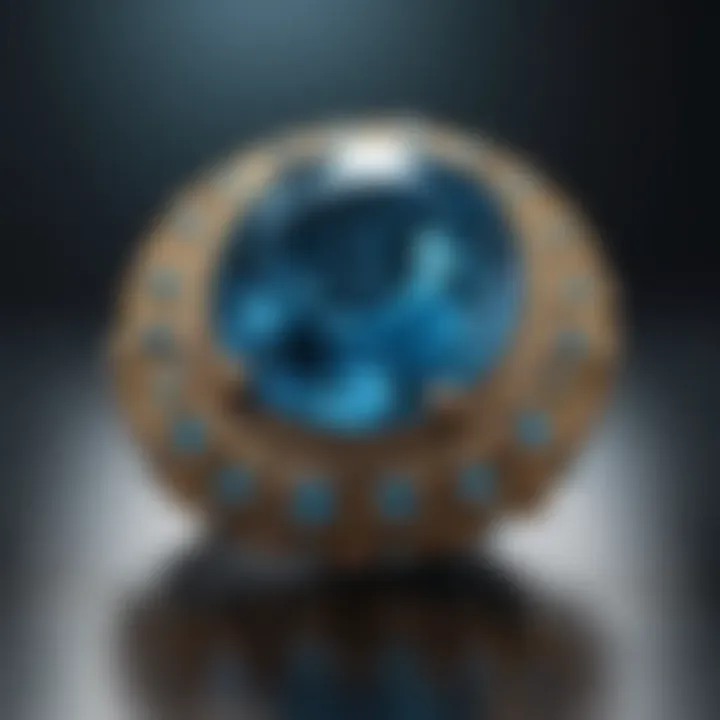
Intro
Topaz, a gemstone that's been cherished for centuries, is a compelling example of nature's artistry. With a palette spanning from tranquil blues to fiery oranges, topaz is not only visually captivating but also steeped in history and culture. As an enthusiastic collector or a curious designer, understanding the various facets of topaz can deepen your appreciation for its beauty and craftsmanship. This guide is designed to take you on an exploration of the colors of topaz, diving into the origins of its hues, the geological processes at play, and the cultural significance tied to each shade. Grab a seat; we are about to embark on a vibrant journey through the world of this multi-colored gemstone.
Gemstone Overview
Definition and characteristics
Topaz is a silicate mineral of aluminum and fluorine that forms in a tetragonal crystalline structure. Polished to perfection, its translucence reflects light in stunning ways. Notably, the gem comes in a variety of colors, a feature that not only enhances its allure but also speaks of its complex geological pathways. Depending on impurities, radiation exposure, and other environmental conditions, topaz can be brown, yellow, blue, pink, or even colorless.
Classification of gemstones
In the grand tapestry of gemstones, topaz holds a substantial seat. Gemstones can be broadly categorized into two groups: precious and semi-precious. Traditionally, topaz is classified as a semi-precious stone, which means it is less rare than precious stones like diamonds or emeralds but still possesses a unique charm that appeals to many. Furthermore, various shades of topaz have their own specific classifications and market values.
- Precious Gemstones: Diamonds, Rubies, Sapphires, Emeralds.
- Semi-Precious Gemstones: Topaz, Amethyst, Garnet, Opal.
"Topaz is not just a stone; it’s a canvas upon which nature paints her masterpiece."
Properties of Gemstones
Physical properties
Topaz boasts an impressive Mohs hardness of 8, which makes it quite durable for daily wear in jewelry. Its crystal system typically forms prismatic crystals that can be quite large, sometimes weighing several carats, with some specimens showing beautiful color zoning. Additionally, topaz exhibits strong pleochroism, meaning it can display different colors when viewed from different angles, enhancing its allure.
Chemical properties
The chemical composition of topaz primarily consists of aluminum, silicon, oxygen, and fluoride. The presence of trace elements like iron or chromium can influence its color; for example, the golden-yellow hue comes chiefly from iron inclusions, while the blue variety often results from exposure to radiation. Understanding these chemical foundations adds another layer to the appreciation of topaz and its many forms.
Intro to Topaz Colors
Topaz is more than just a pretty bauble—it's a gemstone that tells a story through its vivid colors. The myriad hues of topaz have fascinated people for centuries and continue to capture the imaginations of gem enthusiasts, collectors, and jewelry designers alike. Understanding the spectrum of colors in topaz is essential for anyone who wishes to appreciate its beauty fully and make informed choices when buying or using this gemstone.
When we talk about topaz colors, we are not just discussing aesthetics; we're diving into the very essence of what makes this stone unique in the world of gems. Each shade of topaz emanates its own charm, influenced by various geological processes and cultural significance. The colors of topaz range from the soothing blues of the sky to the warm, golden tones reminiscent of sunrise.
What Makes Topaz Unique?
At its core, topaz has a distinctive crystalline structure, often found in igneous rocks and alluvial deposits. Unlike many other gemstones, topaz can not only be found in a variety of hues but also in varying degrees of clarity and intensity. This diversity results from the presence of different trace elements such as iron, chromium, and vanadium.
Additionally, the way topaz is treated can greatly affect its final color. Natural topaz—while beautiful on its own—can be heat-treated or irradiated for enhanced coloration, making it even more appealing to collectors and jewelry makers. The stone isn’t just pleasing to the eye; its durability gives it an edge, making it suitable for daily wear while maintaining elegance in design.
The allure of topaz transcends its physical properties. It also embodies emotional and symbolic meanings in various cultures. This makes each piece not just a stone but a bearer of history and sentiment.
The Geological Formation of Topaz
Topaz forms in a fascinating setting that showcases the natural processes of our planet. Typically, it's found in the cavities of volcanic rocks, particularly in ryholite and granite formations. It's during the cooling phase of magma that topaz crystallizes, leading to its unique properties. This crystalline structure can be attributed to the slow rise of magma through the earth's crust, a process that might take millions of years.
Furthermore, erosion plays its part in bringing topaz closer to the earth's surface where it can be mined. Alluvial deposits are another crucial source where topaz can be extracted from sedimentary environments, showcasing the intricate interplay between geological activity and gem formation.
"The rich history embedded in each topaz stone is as profound as its color spectrum."
The geographical locations where topaz is found add another layer to its uniqueness. Brazil, the United States, Australia, and various regions in Africa host some of the most sought-after topaz deposits. Each locale contributes its own subtle nuances in color and quality, further enriching the narrative surrounding this captivating gemstone.
In summary, understanding the colors of topaz opens a window into the geological wonders of our planet and the significant cultural stories tied to this beloved gem. For enthusiasts and designers alike, there is much to discover in the vibrant world of topaz.
The Spectrum of Topaz Colors
The spectrum of topaz colors is a fascinating aspect of this gemstone that goes beyond mere aesthetics. Understanding these colors helps enthusiasts appreciate the nuanced qualities that make topaz a sought-after stone in jewelry and collection. Each shade not only presents a unique visual allure but also carries significant value and emotional resonance. The interplay of geological factors and human interventions brings forth a rich array of hues, making it essential to consider the spectrum of colors when evaluating topaz.
Natural Colors of Topaz
Topaz can exhibit a range of natural colors, which includes, but is not limited to, blue, yellow, golden, and brown. Each of these hues stems from specific trace elements and environmental conditions during its formation. For instance, the vibrant yellows and browns appear due to iron impurities, while blue topaz often forms as a result of irradiation and the subsequent alteration in its crystal structure. This natural chromatic array not only gives each piece of topaz its unique charm but also influences its market value significantly.
- Color Variability:
The natural colors can vary widely. For instance: - Cultural Significance:
Different cultures have ascribed varying meanings to these colors. In some traditions, blue topaz is believed to promote tranquility while yellow topaz is thought to embody personal power.
- Blue shades range from light sky blue to deep, vibrant azure.
- Yellow and brown topaz may present deeper, richer tones or lighter, more subtle shades.
This variability is a key element for collectors and those who seek distinctive pieces to add to their jewelry.
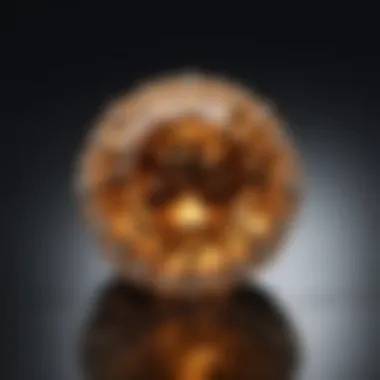
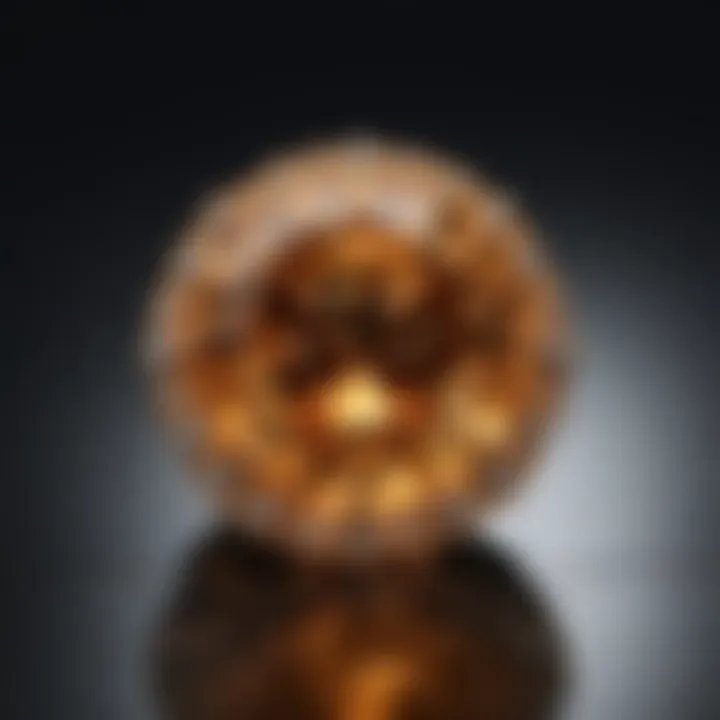
Heat-Treated and Irradiated Topaz Variants
The practice of heat treatment and irradiation has added another layer to the topaz color spectrum. These processes can intensify or alter the natural hues to create strikingly beautiful variants.
Heat Treatment: This technique typically involves exposing the stone to high temperatures, which can enhance or change its color. The resulting shades are often more vivid and sought after in the market. For example, the classic Swiss blue topaz results from treating colorless topaz through heat procedures, transforming its appearance to a brilliant blue that is favored in contemporary jewelry.
Irradiation: On the flip side, irradiation can create colors that are not found in nature. One prime example includes the shocking deep blue colors that can arise from this method. Unlike natural formations, these colors may evoke a contemporary or even artificial feel, which may or may not be appealing to certain collectors or buyers.
"It's not just the color of the stone; it's the story behind each hue that makes topaz precious."
For buyers, understanding the difference between natural and treated stones is vital in making informed decisions about value and authenticity. Collectors often debate the merits of each, where some appreciate the unaltered natural beauty while others seek the vibrant offerings of treated variants.
In closing, the spectrum of topaz colors presents an intricate tapestry woven from natural phenomena and human ingenuity. Whether one seeks the grounding qualities of natural specimens or the dazzling allure of treated stones, both contribute significantly to the gemstone's appeal.
Blue Topaz
In the realm of gemstones, blue topaz stands out for its striking beauty and unique qualities. Among the various hues of topaz, this shade captures the attention of many gemstone enthusiasts and collectors alike. It's not just about aesthetics; the multifaceted nature of blue topaz makes it significant in various contexts, ranging from jewelry design to cultural symbolism. By understanding its characteristics and the emotional resonance behind its color, we can appreciate why blue topaz holds such a high place in the gemstone hierarchy.
Characteristics and Color Variation
Blue topaz typically showcases a stunning array of shades ranging from light sky blue to deep Swiss blue and even the rich tones of London blue. Each hue is a result of natural conditions as well as treatment processes. The lighter shades, often categorized as 'sky blue', seem to shimmer like the serene ocean under sunlight, while the darker variants carry a sense of depth and mystery.
The variations in color intensity stem not just from the natural formation processes but also from enhancements. Most of the commercially available blue topaz is heat-treated and irradiated, which intensifies its hue. This practice raises important discussions about authenticity and value in the market.
Some key characteristics to note:
- Clarity: Quality blue topaz is typically very clear, lacking visible inclusions or blemishes.
- Cut: The brilliance of blue topaz is often enhanced by expert cutting, showcasing the stone's vibrant color.
- Size: Larger stones are generally rarer, often fetching higher prices.
When purchasing blue topaz, buyers should consider these color variations and characteristics as they play a significant role in both the stone's beauty and its value.
Symbolism and Cultural Significance
Blue topaz is not merely admired for its visual appeal. In many cultures, it has been associated with various positive attributes. Traditionally, blue topaz symbolizes calmness, intellect, and communication. People have used it throughout history as a talisman believed to bring peace and enlightenment.
Interestingly, blue topaz also carries significant astrological resonance. It is often associated with the zodiac sign Scorpio, believed to enhance the wearer's positivity and help mitigate negativity. Additionally, many consider it a birthstone for December, linking it to qualities like love, loyalty, and fidelity.
In modern contexts, the stone is often gifted between friends or lovers, symbolizing the promise of fidelity and trust. The cultural significance of blue topaz encompasses various uses in jewelry and ornamental items, further solidifying its position in prestige and elegance.
"Blue topaz not only embodies beauty but also acts as a bridge connecting emotions and intellect," notes gemstone historian Jane Doe.
To sum up, blue topaz is much more than just a pretty stone. Its vibrant colors and rich symbolism make it a continual source of fascination and appreciation in the gemstone world.
Imperial Topaz
Imperial Topaz is a gem that often takes the spotlight among the various hues of topaz, and for good reason. This variety boasts an almost royal allure, captivating both collectors and jewelry designers alike. The warm, rich colors of Imperial Topaz can elevate the simplest of jewelry designs, making it a favorite for those looking to add a touch of elegance. It’s not just the beauty that makes Imperial Topaz significant but also its rich history and the stories associated with its discovery and significance.
Defining Features and Color Range
When we talk about the defining features of Imperial Topaz, it’s essential to mention its color range. Typically, this variety of topaz exhibits an attractive palette from golden yellow to a rich orange and even deep reddish hues. The most sought-after shade of Imperial Topaz is often described as a vibrant orange with rosy undertones. This captivating color can range from soft peachy tones to more intense coppery oranges. The beauty lies in its variability, but the presence of those reddish hues sets it apart from other topaz variants.
The unique colors of Imperial Topaz stem from traces of chromium and iron present in the stone, which imparts the hues that collectors prize.
It’s worth noting that genuine Imperial Topaz is rare. Many gems on the market may carry the name, yet fail to meet the quality or color characteristics. Buyers should look for stones that not only exhibit striking color but also possess clarity and minimal inclusions. The sheer brilliance of a well-cut piece can display a captivating play of light, further enhancing its desirability.
Cultural Context and Historical Value
The history of Imperial Topaz is steeped in cultural significance, lending it a value that transcends just monetary worth. This gem was named in honor of the Brazilian Emperors who ruled in the 19th century, after large deposits were discovered in the region. The symbolism tied to this stone includes strength, confidence, and wisdom, which might explain why it was often favored by royalty.
In various cultures, topaz has held significant meaning. In ancient Egypt, it was believed that the stone could provide protection and bring wisdom and foresight, while in other traditions, it was thought to bring good fortune. Imperial Topaz often found its place in religious artifacts and royal jewelry, serving as a testament to its enduring appeal.
Moreover, the modern-day fascination with Imperial Topaz speaks to its versatility. As fashion trends evolve, this stone continues to shine brightly—adorned in everything from vintage brooches to contemporary pendants. Its balance between luxury and approachability captures the imagination of gemstone lovers and fashion aficionados alike.
Other Notable Topaz Hues
Topaz, a gem celebrated for its variety of colors, is often pigeonholed into well-known shades like blue and imperial. However, this stone has much more to offer in terms of its palette. Exploring the lesser-known hues, such as yellow, colorless, champagne, pink, and red topaz, is essential to understand the gemstone's full character. Each of these varieties not only showcases distinct aesthetics but also flaunts unique stories rooted in geology and culture.
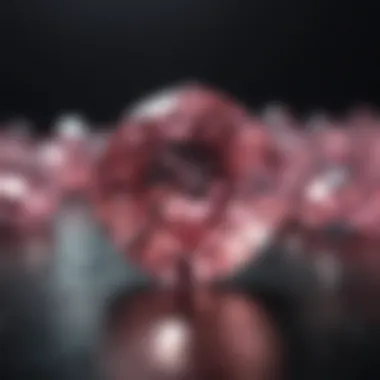

Yellow and Golden Topaz
Yellow and golden topaz, often likened to a ray of sunlight captured within a gem, can range from soft lemon yellows to deep, rich golds. These colors arise primarily from trace elements like iron and chromium during the mineral’s formation. Furthermore, the solar glow of this topaz makes it a favored choice for those yearning for warmth in their jewelry pieces. Notably, the deeper the hue, the more sought after the stone becomes due to its rarity.
Yellow topaz embodies meanings of wealth and prosperity, dating back to ancient civilizations where it was seen as a stone of good fortune. Today, many wear it as a talisman to invite those positive energies. Here’s what to consider:
- Clarity: Clear stones are valued more than those clouded by inclusions.
- Intensity: The deeper the yellow, typically the higher the price.
- Settings: Yellow and golden topaz are often set in gold to enhance their warm tones.
Colorless and Champagne Topaz
Colorless topaz, sometimes mistaken for a diamond, offers sharp and clear brilliance. Its lack of color can be a double-edged sword; while it can take on the appearance of more expensive gems, it sometimes gets overlooked due to its simplicity. Champagne topaz, on the other hand, introduces a subtle elegance. This hue, which ranges from soft beige to darker, more robust shades, is reminiscent of sparkling wines and opposes the vibrancy seen in other topaz varieties.
Both colorless and champagne topaz offer versatility in jewelry contexts. They pair beautifully with various gemstones and metals, appealing to those who appreciate understated luxury. When evaluating these stones, keep in mind:
- Cuts: Ideal cuts can enhance the stone's natural sparkle.
- Purity: Fewer inclusions again spell higher desirability.
- Durability: Both types are quite sturdy, making them suitable for daily wear.
Pink and Red Topaz
Pink and red topaz, although rare, bring a passionate flair to the topaz family. The pink variety is often linked to emotional well-being and compassion, making it popular among not just collectors but also those seeking meaning in their jewelry. Red topaz, with its fiery hue, is a powerful stone, symbolizing strength and health. Its vibrant color derives from traces of manganese and chromium, imparting a distinctive allure.
Here’s why these hues catch the eye:
- Rarity: Notable pink and red topaz can fetch high prices due to how uncommon they are in the market.
- Variants: Each shade can differ substantially in terms of depth, affecting their appeal to different collectors.
- Cultural significance: The pink hue is often associated with love and harmony, making it a romantic choice for gifts.
"The rich colors of topaz tell a story far deeper than what glimmers on the surface; they are tales woven through time and nature."
Acknowledging these other notable hues provides a broader understanding of topaz beyond its well-known shades. Incorporating such gems into collections or jewelry not only adds variety but also celebrates the rich history and cultural significance they carry.
Physical Properties Related to Color
When considering topaz, the conversation often shifts towards its captivating colors, yet the foundation of those vibrant hues lies heavily in its physical properties. Understanding features such as transparency, clarity, and the interplay of color with these attributes is vital for gemstone enthusiasts. Not only do these elements define the visual appeal, they also influence the stone’s value and durability, guiding collectors and jewelry designers alike in their choices.
Understanding Transparency and Clarity
Topaz is known for its range of transparencies. This aspect is crucial, as it directly affects the gem's overall appearance. A piece with high transparency allows light to pass through unimpeded, showcasing the brilliance and depth of its color. In contrast, a stone with lower transparency might appear dull or cloudy, diminishing its desirability.
Moreover, clarity plays a key role in how one perceives the color of topaz. A crystal that is clear and free from inclusions will often display a more vivid hue. Think of it this way: if you have a tinted window, the view beyond can be altered by smudges or dirt. The same principle applies to topaz. If the clarity is compromised by inclusions, even the richest color might seem less vibrant than it really is.
Lastly, the nuances of transparency and clarity can shift how color is interpreted. A vibrant blue topaz with crystal-clear clarity will demand a higher price than a murky counterpart, as its allure is intensified by the light interacting optimally with both the color and the gem’s structure.
"Transparency and clarity are the unsung heroes of topaz colors; they can make or break the gem's overall aesthetic."
How Color Impacts Durability and Value
Color does not solely reside within the aesthetic domain; it also intertwines with durability and market value. The chemical composition of topaz influences its color, so the hue can dictate how resilient the stone is. For instance, darker or more intensely colored variants may exhibit a robustness that lighter counterparts lack, thus impacting how these stones fare over time.
From a valuation standpoint, various shades of topaz carry different price tags based on rarity and demand. Blue topaz, widely sought after, often holds a higher market value. In contrast, a cloudy or less vibrant light yellow or brown topaz may fetch a considerably lower price. The reason is simple: rarity and appeal drive demand, and in the gem world, color is a significant factor.
In a nutshell, when evaluating topaz, it's essential to consider that its color does not act in isolation. The convergence of transparency, clarity, and the inherent color properties combine to define both its beauty and value. Collectors and designers need to be well-versed in these aspects to make informed decisions that cater to aesthetic preferences while ensuring long-lasting quality.
Assessing Topaz Quality
When diving into the realm of topaz, it's crucial to understand what makes a stone truly exceptional. Topaz quality is assessed based on several important factors that directly affect its desirability and value. Knowing how to evaluate these qualities can help buyers make informed decisions and collectors appreciate the intricacies of their stones.
Evaluating Color Intensity and Consistency
Color is undoubtedly one of the most significant aspects of topaz. It’s not just about whether a stone is blue or yellow; the intensity and uniformity of that color can greatly influence its appeal. To evaluate color intensity, consider the following:
- Shade Depth: The deeper and more vivid the hue, the higher the quality. For example, a rich imperial orange or a bright sky blue topaz stands out far more than a pale or washed-out version.
- Color Consistency: Look for stones that exhibit a uniform color throughout the entire gemstone. Variations in shade can detract from its overall beauty, making it less desirable.
- Lighting Effects: Observe how the color changes in different lighting conditions. High-quality topaz maintains its color saturation whether in natural sunlight or artificial light.
Buyers should also keep in mind that natural color variations exist. While they can add character, excessive inconsistencies may lower the perceived quality of the stone.
Identifying Authenticity in Topaz
Unfortunately, not all topaz available in the market is genuine. Making sure that a gemstone's authenticity is yardstick for assessing its quality is imperative. Here are a few tips to help identify authentic topaz:


- Reputable Sources: Always purchase from credible jewelers or gemstone dealers. Research their reputation and read customer reviews.
- Gemmological Certification: Look for stones accompanied by a certificate from recognized gemological laboratories. Certifications offer proof of the stone’s authenticity and its specific characteristics.
- Visual Clues: Genuine topaz will typically have a clarity and brilliance that synthetic replicas can hardly match. Be on the lookout for bubbles or cloudiness, which may hint at a glass imitation.
- Scratch Test: Topaz ranks 8 on the Mohs scale of hardness. If the stone easily scratches when placed against materials like quartz, it might not be the real deal.
"The true essence of a gemstone lies not just in its appearance, but in its authenticity and the tale it tells through its history."
Identifying authenticity often necessitates a keen eye and perhaps some expert consultation, but doing so will ensure you’re investing in a genuine piece of beauty, which in turn supports the overall quality of your collection.
As you navigate through the color spectrum of topaz, the skill of assessing quality becomes an invaluable tool. By sharpening your evaluation techniques through understanding color intensity, consistency, and authenticity, you position yourself to appreciate these exquisite gems even more.
Buying and Caring for Topaz Jewelry
When it comes to purchasing and maintaining topaz jewelry, making informed choices can greatly enhance your experience with this vibrant gemstone. Understanding the significance behind the colors and knowing how to properly care for your pieces enriches not just your collection but also your appreciation for topaz in general.
Selecting the Right Shade for You
Choosing the right shade of topaz that resonates with your personal style can be an enjoyable process. The diverse palette of topaz can range from the deep blues of the blue variants to the warm hues of yellow and the delicate blush of pink. Here are some points to ponder when selecting your stone:
- Personal Preference: Think about what colors you wear most often. If you're usually in earthy tones, a warm golden topaz may complement your wardrobe beautifully.
- Skin Tone Compatibility: Certain colors may enhance your natural skin tone better than others. Often, cooler skin tones look stunning with blue topaz, while warmer skin tones might shine with yellow or golden shades.
- Occasion Suitability: Consider where and when you'll be wearing the jewelry. A flashy imperial topaz may be perfect for a formal affair, while a subtle champagne topaz can be suited for daily wear.
The choice of shade doesn’t just reflect your style, it can also symbolize various emotions or aspirations. Each shade of topaz carries its unique charm and meaning, making it a deeply personal choice.
Maintenance and Preservation Tips
To keep your topaz shining brightly and looking its best, it requires some considerate care. These maintenance tips will help ensure that your jewelry remains in tip-top shape:
- Regular Cleaning: Use a soft cloth to wipe your topaz after each wear. For deeper cleaning, a mix of mild soap and warm water can do wonders. Be sure to avoid harsh chemicals that can damage the stone.
- Storing Properly: Store your topaz jewelry away from other gemstones in a soft pouch or lined box. This helps to avoid scratches caused by harder stones.
- Avoiding Heat: Prolonged exposure to direct sunlight or heat sources can affect the color of your topaz, particularly those that have been treated. Always let your jewelry remain in a cool, dry place.
- Regular Check-ups: If your stone is set in jewelry, consider having it checked by a professional jeweler periodically. They can ensure the settings are secure and check for any signs of wear.
"A little care goes a long way; treating your topaz jewelry with respect and love will keep its beauty for many years to come."
In summary, knowing how to buy and care for your topaz jewelry not only enhances its beauty but also its longevity. Whether you're drawn to the expansive color spectrum for personal adornment or as an investment, a thoughtful approach will ensure that your pieces remain a cherished part of your collection.
Topaz in Cultural Context
The cultural context of topaz is as rich as the myriad colors it embodies. Throughout history, topaz has held a special place in human societies, valued not just for its aesthetics but also for its alleged properties and meanings. Understanding topaz within this broader framework enhances one's appreciation of the stone—beyond its physical characteristics—to encompass its societal importance and the mythologies that surround it.
Topaz in History and Mythology
The history of topaz is teeming with narratives that span across civilizations, each attributing unique significance to the gemstone.
- In Ancient Egypt, topaz was thought to be the gemstone of the Sun God, Ra, symbolizing power and protection. This mystical belief led to the use of topaz in amulets, crafted to ward off evil spirits.
- Similarly, the Greeks believed that topaz had special powers, enhancing strength and making its wearer invisible in times of danger. This notion permeated various cultures, with the Romans likewise recognizing topaz's strength as a protective stone.
- Moving through the ages, topaz also played a role in the lives of European nobility. In medieval times, it was believed to maintain harmony within kingdoms, often fashioned into royal jewelry to symbolize peace and loyalty.
The stone’s color variations often represented different attributes. For example, the vibrant yellow hues were associated with wealth, while the softer pastel shades indicated tranquility and wisdom. This blend of historical narrative and gemology illustrates how topaz clouds people's perceptions.
"In the interplay of culture and crystal, topaz emerges not just as a gemstone, but as a storyteller, conveying tales of ancient civilizations and their beliefs."
Modern Uses and Symbolism
In modern times, topaz continues to thrive in various facets of culture and commerce, not merely as an ornamental stone but also as a symbol of beauty and healing.
- Jewelry: One of the primary modern uses of topaz is in the jewelry industry. Its color choices allow for popular pieces that cater to diverse tastes—from bold and colorful statement rings to delicate, understated pendants.
- Birthstone: Topaz serves as the traditional birthstone for November. Positioned as a symbol of love and affection, it is often given as a gift to signify deep and lasting bonds.
- Healing Properties: Many contemporary holistic practitioners advocate for the emotional and physical healing potential of topaz. They believe it promotes self-realization and problem-solving, helping individuals to express their thoughts and feelings openly.
Besides these uses, topaz's symbolic themes often encapsulate a deeper connection to emotions such as attachment and devotion. Its multifaceted nature makes it a favored choice among gemstone enthusiasts and collectors alike.
As one can see, topaz transcends its role as a mere decorative item; it embodies a rich tapestry of cultural significance and mythology, continuously evolving through each era.
Ending
The conclusion of this comprehensive guide serves as a crucial component in reinforcing the significance of the diverse colors of topaz. This section highlights not just the aesthetic beauty of topaz but also its geological background and cultural depth. Understanding the colors of topaz allows enthusiasts, both collectors and casual admirers alike, to appreciate the complex processes that contribute to each gemstone's unique coloration.
Summarizing Topaz Colors and Their Importance
Topaz is much more than just a pretty stone; it's a window into the Earth's geological history, colored by natural forces and human intervention. Each hue, from the mesmerizing blue to the rare pink, tells a story of formation and transformation. For gemstone collectors, the importance lies in recognizing which colors hold greater value, due to their rarity, quality, and demand in the marketplace. Moreover, each color is deeply intertwined with cultural symbolism that can enhance its allure. For instance, blue topaz, often associated with tranquility and communication, invites wearers to celebrate their personal journeys and connections.
In a world where many often overlook the subtleties of nature, the characteristics of topaz colors remind us of the intricate beauty found in diversity. They not only serve as decorative pieces but also as tangible links to an ancient past and a glimpse of our cultural narratives. By understanding the importance tied to these colors, collectors can make more informed decisions and cultivate a deeper appreciation for their collections.
Encouragement to Explore Further
For those intrigued by the multifaceted world of gemstones, the journey doesn't stop here. There’s a wealth of knowledge waiting to be uncovered—from exploring lesser-known varieties of topaz to diving deep into its mining origins and ethical sourcing. Being an informed collector goes beyond just aesthetics; it's about connecting with the story each stone carries.
I encourage you to dig deeper into resources available online, such as Wikipedia and Britannica, to enhance your understanding and appreciation of topaz. Joining communities on platforms like Reddit can also provide insights from fellow enthusiasts and help you stay updated on trends in the gemstone market.
Ultimately, knowledge empowers you to not only select the perfect topaz but to become a custodian of its narrative, celebrating its vibrant hues long after it adorns your collection. Whether you're a jewelry designer seeking inspiration or a history buff eager to uncover stories of the past, there's always more to learn and explore.



